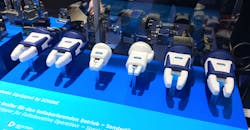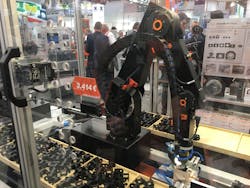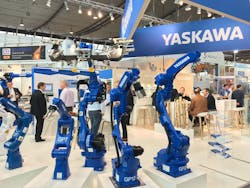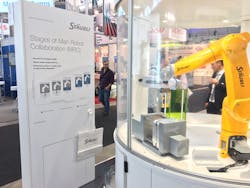Robotic Innovations Take Center Stage at Motek Fair 2017
It’s a fact: The world of robots is coming, and there’s nothing we can do to stop it. Robots are becoming smarter, easier to integrate, and safer for human collaboration, and the market is diversifying quickly so that any engineer or designer can enter. Motek Fair 2017 took place during the month of October and showcased efforts to enable better collaboration of robots, as well as to provide enhanced features for more optimized manufacturing.
igus Robolink
Creating an attractive price point is key for robots. Many industrial-size robotics are costly and unaffordable for many engineers. The new line of igus plastic motion parts attempt to lower the price point of robotic components while still providing quality motion parts. Among those components are robot joints with direct drive with a compact design, including plastic worm gear, a plastic wave gear, different rope drives, and also an open-source software platform to control the robotic arm. Users can either build the robot arm themselves, mixing and matching igus components with other supplier parts, or else purchase a complete robot arm from the company.
Yaskawa’s Industrial Robot Line
Industrial robots now come in all shapes and sizes. The industrial line from Yaskawa offers robotic arms for different types of industries and tasks within those industries. The GP line offers improved acceleration and deceleration control for all robot positions. The small footprint of the GP line eases installation space requirements and minimizes interferences with other surrounding equipment. A single cable is needed to connect the end effector to the controller, resulting in an easy setup. The GP 7 robotic arm on the left is ideal for high-speed assembly and handling applications. The line increases in size and power; the GP 25 on the right offers the highest payload option at 25 kilograms.
New End Tools for Kuka Robots
Kuka robots are some of the most well-known robotic arms in the industrial space. Featured above is the LBR iiwa collaborative robot, which has a new special tool: the Kuka A/B and C class screwdriver. This provides robot engineers with an out-of-the-box automation solution for manual screw fastening processes. It can be used in high-torque applications and is capable of multi-stage fastening. The screwdriver is lightweight, easy to integrate into existing production systems, and has no external lines or disruptive forces due to its integrated energy supply.
Schunk’s Safety Cobot Grippers
Cobots are designed to work with humans, and the new line of collaborative grippers from Schunk take the shared workspace one step further. These grippers operate on three principles: 1) never cause injury when gripping; 2) grippers should always detect human contact; and 3) grippers should never lose a work piece. The grippers from Schunk have built-in safety features that enable them to be used with cobots. They have force limitation settings that are activated in the presence of a human, collision protection to prevent injury, gripping force maintenance, environmental sensor systems to be able to better understand the work environment and humans, and software to evaluate and process signals from built-in sensors. Schunk grippers are compatible with major robotic arms, including those from Universal Robots, ABB, and Kuka.
Alvmac Provides Robots with Sight
Alvmac is not a robotics manufacturer, but its products are essential to make robot systems more human-friendly. Specifically, Alvmac specializes in machine vision. By providing robots with vision systems—including cameras, laser sight, and software for object detection—the company can automate robots to detect products in an assembly, control and inspect parts post-assembly, integrate into assembly lines, and provide complicated pick-and-place applications via high-resolution artificial vision. Machine vision for robots is important to help ease the work of programming robots. By being able to see, robots can visually differentiate objects rather than having to be programmed with each object’s individual parameters, creating an easier workflow.
Yamaha’s Controller Control Operation Concept
At Motek Fair, Yamaha had a complete robotic layout for all your automation needs. The Advanced Robotics Automation Platform offers coordinated motion and synchronized control of all robots and peripheral equipment connected to the system. The line from Yamaha offers the YHX Series programmable logic controllers (PLCs) that can stack up to 16 driver units with a host controller and power unit. The GX series and YLE series of ground ball screws have position accuracy of ±5 µm. The YKX series is a high-speed, high-accuracy, and high-rigidity Scara robot that requires no belt for its direct drive design, along with a reinforced drive mechanism featuring an industry-leading short cycle time.
Stäubli’s 5 Stage Cobot
The new line of collaborative robots from Stäubli, offers an all-in-one robot for industrial and collaborative applications. The new TX2 line includes sensors that monitor movement of the robot, while the speed, coordinates, and acceleration are recorded in real-time. These sensors are used for the built-in safety measures that allow the robot to be used in close human proximity. The different stages of the robot are broken into five categories.
- Stage 1: Hard guarding separates the operator and robot. The manufacturing process is performed by the robot.
- Stage 2: Laser (virtual) guarding separates the operator and robot. The manufacturing process is performed by the robot, and the operator enters the area periodically.
- Stage 3: Laser (virtual) guarding separates the operator and robot. The robot and operator are involved in the manufacturing process. The operator enters the zone regularly during production.
- Stage 4: There is no separation between the robot and operator as both are involved in the manufacturing process. The robot stops when it comes into contact with the operator.
- Stage 5: Again, there is no separation between the robot and operator. The robot and the operator move safely in the same space simultaneously.








